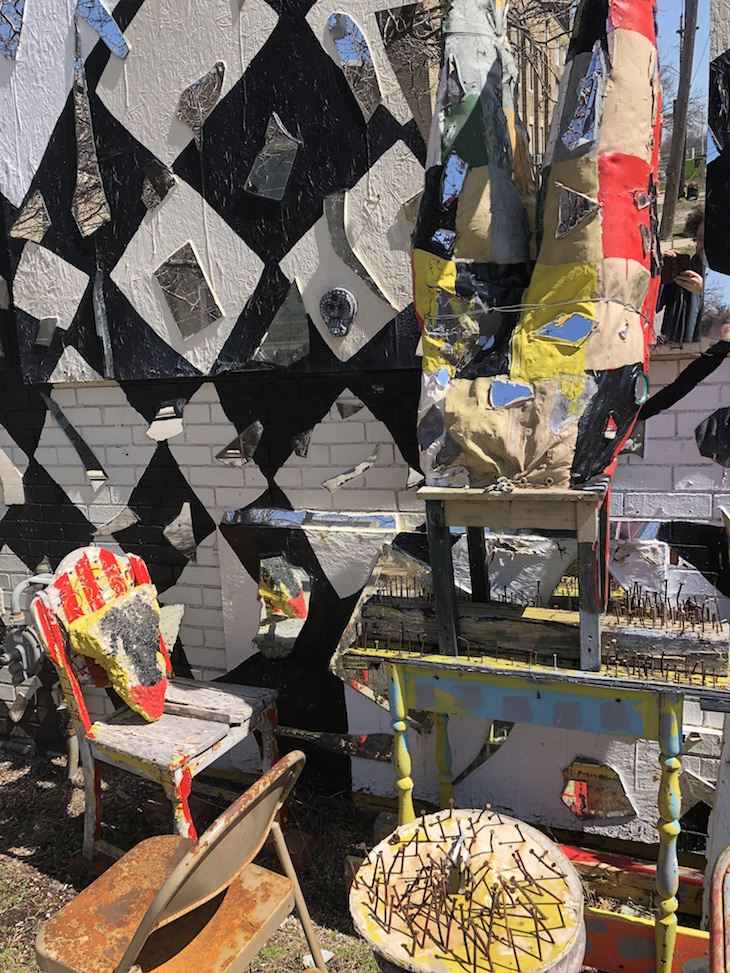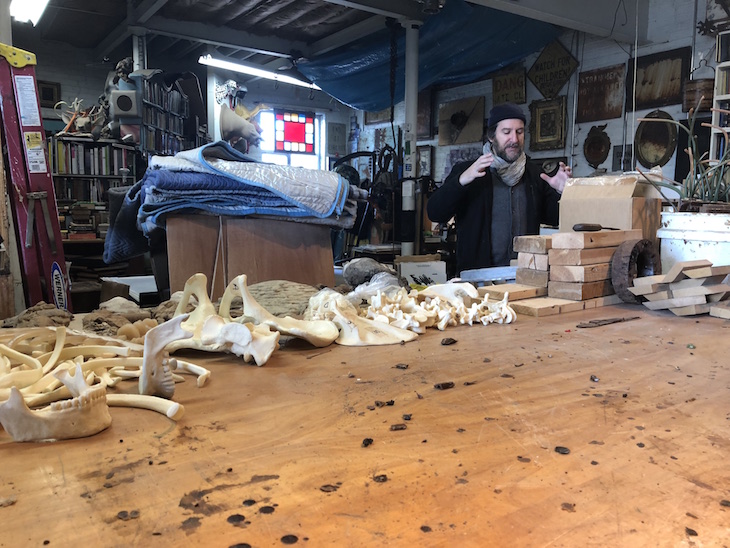Writing about Detroit is intimidating. For decades, particularly since the Great Recession, the city’s failures have been spun into elegies for the American Dream. Recently Detroit has been subjected to the opposite fate, with premature panegyrics to its revival. Covering a vast territory of roughly 140 square miles – in which newly refurbished lofts and hipster hangouts sit a stone’s throw from the slouching, scabrous shells of abandoned homes – Detroit can sustain either narrative, demise or rebirth. All it takes is a carefully managed tour (This way to the ruin porn!) and some confirmation bias to get Detroit entirely wrong – to force it to tell the kinds of stories that its long-time residents rightly disdain.
I fumbled my way toward this insight belatedly, after a week of whiplash suffered while trying to come to terms with the city’s contrasts and paradoxes. I flew to Detroit with my curatorial partner, Catriona Laing, to scout sites and artists for our public arts project, ‘Stations of the Cross’. The project has travelled from London to Washington, D.C., to New York City, and will head to Detroit in 2020. The idea is to curate a creative pilgrimage through each host city, translating the 14 stops on Jesus’s journey through Jerusalem – from condemnation to crucifixion – into sites that speak to contemporary injustice. We commission new works and try to uncover new ways of thinking about existing works. The pull of Detroit was irresistible. The metropolis’s issues – industrial decline, white flight, local corruption, authoritarian state and federal management, corporate cronyism, and more – constitute the kind of ganglia curators love to probe.
We were fortunate to have Bill Danaher, the ebullient rector of Christ Church Cranbrook, play the part of Virgil as we crisscrossed the city, passing from purgatory to paradise and back again more times than I could count. As we glimpsed the darkened husks of some abandoned churches on the way into the city centre, I declared our search over. We’d found the perfect site for our exhibition. Bill was nonplussed. ‘You’ve got baby duck syndrome,’ he said: ‘You haven’t seen anything yet.’ He was right, of course. There were plenty more abandoned buildings, from schools to post offices and libraries, each bearing pathetic witness to the prosperity and lofty civic-mindedness of previous generations. At times, even the ruins seemed to beget ruins. Tyree Guyton’s Heidelberg Project, a mélange of outdoor paintings and sculptures composed of derelict houses and urban flotsam, has been hit repeatedly in recent years by arsonists and vandals, turning a once celebratory profusion of colour into a rather disappointing relic.
More cheering was the African Bead Museum, designed and curated by Olayami Dabls. Inside a dilapidated house, the avuncular Dabls presides over a shop with necklaces sourced from around Africa. Outside – using everything from rebar to broken mirrors – he has created a Gesamtkunstwerk, fusing elements from Aboriginal bark paintings, West African masks, and mid-century abstraction.

Exhibits at the African Bead Museum in Detroit, designed and curated by Olayami Dabls. Photo: the author
On a subsequent outing, Bill introduced us to Scott Hocking, a sort of urban lumberjack-cum-spelunker, who has spent decades climbing under chain-link fences and disregarding safety notices in order to build haunting, monumental structures in and around empty factories. Noting it wouldn’t be a proper tour without doing something vaguely illegal, Hocking nonchalantly informed us as he drove up to a level crossing that we were going to beat the train whistling towards us. We guffawed, sensing a bluff. We sped around the blinking barriers, leaving the rector paler than the Holy Ghost. Hocking went on to retrace some of the routes he had scouted for Matthew Barney’s operatic film River of Fundament (2014), as well as some of his own favourite stamping grounds. Highlights included a boarded-up church surrounded by a sewage treatment plant, an eerily phosphorescent canal (‘a great place to kayak!’), and a sculpture- and skate-park alongside a main thoroughfare.

Scott Hocking with sculptures in his studio, Detroit. Photo: the author
The park was the brainchild of Mitch Cope and Gina Reichert. When we arrived, they were watching their young daughter skateboard next to a monumental sculpture by the New York artist Nari Ward, and had plans to take her to a puppet show later at the Detroit Institute of Arts. I felt exceptionally uncool. Together, Cope and Reichert run Power House Productions (PHP), a fascinating neighbourhood-based non-profit which has converted a cluster of small houses into performance and studio spaces. There is even a Squash House, ‘a sculptural sports arena and greenhouse centered around squash – the sport and the vegetable’.
However quirky, Squash House felt like an apt metaphor for the Detroit art scene. Creative projects seem to grow best here in native soil, tended by people who have weathered lean years and can read the cultural climate. Real Detroiters are tired of their city being a symbol. They just want to make things.
From the June 2018 issue of Apollo. Preview and subscribe here.

‘Real Detroiters are tired of their city being a symbol’
The African Bead Museum in Detroit, designed and curated by Olayami Dabls. Photo: the author
Share
Writing about Detroit is intimidating. For decades, particularly since the Great Recession, the city’s failures have been spun into elegies for the American Dream. Recently Detroit has been subjected to the opposite fate, with premature panegyrics to its revival. Covering a vast territory of roughly 140 square miles – in which newly refurbished lofts and hipster hangouts sit a stone’s throw from the slouching, scabrous shells of abandoned homes – Detroit can sustain either narrative, demise or rebirth. All it takes is a carefully managed tour (This way to the ruin porn!) and some confirmation bias to get Detroit entirely wrong – to force it to tell the kinds of stories that its long-time residents rightly disdain.
I fumbled my way toward this insight belatedly, after a week of whiplash suffered while trying to come to terms with the city’s contrasts and paradoxes. I flew to Detroit with my curatorial partner, Catriona Laing, to scout sites and artists for our public arts project, ‘Stations of the Cross’. The project has travelled from London to Washington, D.C., to New York City, and will head to Detroit in 2020. The idea is to curate a creative pilgrimage through each host city, translating the 14 stops on Jesus’s journey through Jerusalem – from condemnation to crucifixion – into sites that speak to contemporary injustice. We commission new works and try to uncover new ways of thinking about existing works. The pull of Detroit was irresistible. The metropolis’s issues – industrial decline, white flight, local corruption, authoritarian state and federal management, corporate cronyism, and more – constitute the kind of ganglia curators love to probe.
We were fortunate to have Bill Danaher, the ebullient rector of Christ Church Cranbrook, play the part of Virgil as we crisscrossed the city, passing from purgatory to paradise and back again more times than I could count. As we glimpsed the darkened husks of some abandoned churches on the way into the city centre, I declared our search over. We’d found the perfect site for our exhibition. Bill was nonplussed. ‘You’ve got baby duck syndrome,’ he said: ‘You haven’t seen anything yet.’ He was right, of course. There were plenty more abandoned buildings, from schools to post offices and libraries, each bearing pathetic witness to the prosperity and lofty civic-mindedness of previous generations. At times, even the ruins seemed to beget ruins. Tyree Guyton’s Heidelberg Project, a mélange of outdoor paintings and sculptures composed of derelict houses and urban flotsam, has been hit repeatedly in recent years by arsonists and vandals, turning a once celebratory profusion of colour into a rather disappointing relic.
More cheering was the African Bead Museum, designed and curated by Olayami Dabls. Inside a dilapidated house, the avuncular Dabls presides over a shop with necklaces sourced from around Africa. Outside – using everything from rebar to broken mirrors – he has created a Gesamtkunstwerk, fusing elements from Aboriginal bark paintings, West African masks, and mid-century abstraction.
Exhibits at the African Bead Museum in Detroit, designed and curated by Olayami Dabls. Photo: the author
On a subsequent outing, Bill introduced us to Scott Hocking, a sort of urban lumberjack-cum-spelunker, who has spent decades climbing under chain-link fences and disregarding safety notices in order to build haunting, monumental structures in and around empty factories. Noting it wouldn’t be a proper tour without doing something vaguely illegal, Hocking nonchalantly informed us as he drove up to a level crossing that we were going to beat the train whistling towards us. We guffawed, sensing a bluff. We sped around the blinking barriers, leaving the rector paler than the Holy Ghost. Hocking went on to retrace some of the routes he had scouted for Matthew Barney’s operatic film River of Fundament (2014), as well as some of his own favourite stamping grounds. Highlights included a boarded-up church surrounded by a sewage treatment plant, an eerily phosphorescent canal (‘a great place to kayak!’), and a sculpture- and skate-park alongside a main thoroughfare.
Scott Hocking with sculptures in his studio, Detroit. Photo: the author
The park was the brainchild of Mitch Cope and Gina Reichert. When we arrived, they were watching their young daughter skateboard next to a monumental sculpture by the New York artist Nari Ward, and had plans to take her to a puppet show later at the Detroit Institute of Arts. I felt exceptionally uncool. Together, Cope and Reichert run Power House Productions (PHP), a fascinating neighbourhood-based non-profit which has converted a cluster of small houses into performance and studio spaces. There is even a Squash House, ‘a sculptural sports arena and greenhouse centered around squash – the sport and the vegetable’.
However quirky, Squash House felt like an apt metaphor for the Detroit art scene. Creative projects seem to grow best here in native soil, tended by people who have weathered lean years and can read the cultural climate. Real Detroiters are tired of their city being a symbol. They just want to make things.
From the June 2018 issue of Apollo. Preview and subscribe here.
Unlimited access from just $16 every 3 months
Subscribe to get unlimited and exclusive access to the top art stories, interviews and exhibition reviews.
Share
Recommended for you
Onwards and upwards: the mighty Detroit
If anything mirrors Detroit’s rise over the years, it’s the wonderful Detroit Institute of Art
Civic Dues: Graham W.J. Beal
The Detroit Institute of Arts has known hard times in recent years. As he prepares to retire, director Graham W.J. Beal reflects on the museum’s recent struggles and successes
First Look: Diego Rivera and Frida Kahlo in Detroit
In one remarkable year, Rivera arguably made his greatest mural cycle and Kahlo forged her own expressive style